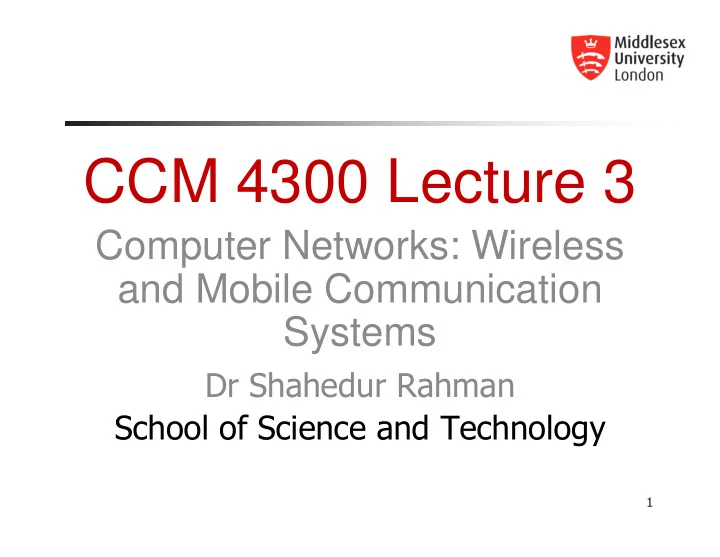

CCM 4300 Lecture 3 Computer Networks: Wireless and Mobile Communication and Mobile Communication Systems ������������������ �������������������������������� �
��������������������� � introduced a classification of computer networks � Introduced circuit and packet switching � � described networks with different scale � introduced the various network standards, how they are created and by whom �
��������������� � Lesson Objectives � Network Topologies � Introduction – an example of human-to-human interaction � What is a protocol? � What is a protocol? � ISO OSI Reference Model - TCP/IP protocol � �������������������������� �
����������������� � At the completion of this lesson you should be able to � understand network logical and physical topologies � understand the concept of layering and structure of the ISO Reference Model � describe the functionality of each layer in the ISO � describe the functionality of each layer in the ISO Reference Model � understand the basic concepts of the client server architecture �
������������������������������� � ������������������������������������������� � �������!�������� ����������������������������"� � �������������������#���������������������� � $�����������������������%��������������������������� ����������������"� � &�����������������������������!��������������������� � &�����������������������������!��������������������� �����������������������������"� � (�����������������!���������������������� �������������������������������������������������� ����������������"�� '
Bus � Each computer is connected to a single cable which connects all of the computers. � This is the cheapest network topology as the smallest amount of cabling is required. � If the network cable breaks anywhere then none of the computers can access the network. )
Ring � Each computer is connected to the two computers on either side of it. � The last computer is linked to the first to form a ring. � If the network cable breaks anywhere then none of the computers can access the network. � Long cable length *
Mesh � Any computer can be connected to any other computer. � There are multiple routes. If one link fails messages can go another way so this topology is very reliable. � The Internet has a mesh topology. +
Star � All communication takes place via a central computer. � If the central computer fails the whole network will break down. � If one of the network cables breaks only the computer connected to that cable is affected. ,
Extended Star � An extended star topology is like a star topology except that each device that links to the centre device is also the centre of another star. � Each of these devices acts as the centre of another star. another star. � An apparent advantage of this is to extend the length and the size of the network. � Limits the number of devices and the numbers of cables needed to interconnect to the central device. � Logically, the information in an extended star topology stays local �-
����(�����!�����.�������$� � ����������������������� ������� � ���������������� /�������. ������������ �����������������������0 � �����������������. �����������������. ���������������������� ����.�������������� � ���!��1���������. ����� �������������������� ���������2����!�3 ��
������������������� � Represent the “rules” for communication: � how do the computers initiate communication? � what features can be negotiated at the start? � the communication vocabulary - i.e. what requests (commands) can be given and what are the valid responses? � what kinds of data can be exchanged ? � how the communication can be closed in an orderly way ? ��
��������������������� ���� � A human protocol and a computer network protocol: �� �������������� �������������� ��*# �� �������������� ������� �����# ��$�� ( )) �������� !!"""#$�%#��#&' +����, ��$� ��
��������������������� ���� � $����������������������������������������������������� �4������� Header Header Data Data Control Message Information ��
��������������������� ���� � For two networked devices to communicate they must speak the same language (i.e. use the same protocol) � The protocols must be able to: - indicate who (what address) they want to talk to - indicate who (what address) they want to talk to - provide any required delivery assurances / recovery - control the flow of information � Must specify how to initiate, maintain and conclude the communications exchange �'
��������������������� ���� � Several protocols are involved in a network � Operate together in a layered manner - each layer builds upon the services of its lower layer(s) File Transfer Workstation End-to-end integrity Remote Internetworking Server Router WAN LAN �)
��������������������� ���� � A protocol (or more typically a protocol suite) is needed for communications - some organisations may use multiple suites (e.g. Novell and TCP/IP protocols) � Protocols are specified in the form of documents and usually implemented in software � A separate software package is needed for each different protocol suite to be supported �*
-�.�.�-�����������/���� � Open Systems Interconnection � Developed by International Standards Organisation (ISO) - 1981 - revised in 1994 � Described in ISO-7498 standard � Proposes 7 layers � Provides: - a common terminology - a framework for networking �+
��������������.�-��������� � A layer should be created where a different level of abstraction is needed � Each layer should perform a well-defined function � The function of each layer should be chosen with a view to defining internationally standardised protocols � The layer boundaries should be chosen to minimise The layer boundaries should be chosen to minimise the information flow across the interfaces � The number of layers should be: - large enough that distinct functions are not thrown together - small enough that the architecture is not unwieldy �,
.�-�����������/���� Source : Computer Networks 1996 ��5��--6����-+ �-
.�-��������� ���� � Application - contains a number of standard protocols of general use - e.g. file transfer protocols, email, virtual - e.g. file transfer protocols, email, virtual terminals, telnet, etc... - any service program may define an application level protocol that clients must use. ��
.�-��������� ���� � Presentation - concerned with the representation of data (e.g. between different hardware, Operating Systems etc.) � Session - allows clients of an OS on one machine to establish and use sessions with clients of an OS on another machine - Controls the dialogue between applications in end systems. -Controls the direction of traffic. - Other functions: recovery, synchronisation, etc.. ��
Recommend
More recommend